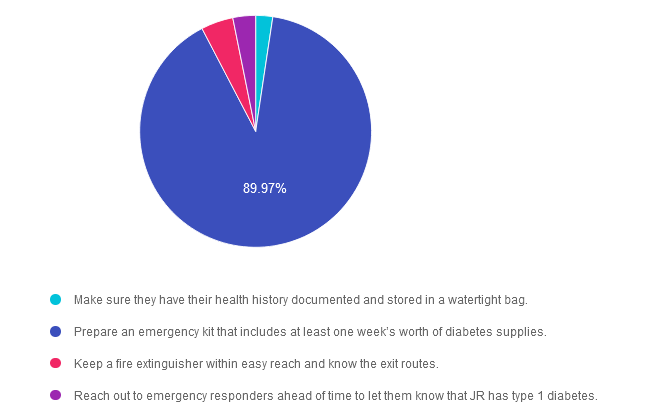For last week’s practice question, we quizzed participants on most important action in case of fire. Most of our respondents chose the best answer. GREAT JOB. We want use this rationale to share important resources on Disaster Preparedness. We encourage you to pass this info on to people living with diabetes and your colleagues. Plus this info will prepare you for exam success!
Before we start though, if you don’t want any spoilers and haven’t tried the question yet, you can answer it below: Answer Question

Question:
JR lives with type 1 diabetes and uses an insulin pump and sensor. They live in an area that is fire prone and JR asks you about how they should prepare for an emergency if evacuation is required.
What action is most important?
Answer Choices:
- Make sure they have their health history documented and stored in a watertight bag.
- Prepare an emergency kit that includes at least one week’s worth of diabetes supplies.
- Keep a fire extinguisher within easy reach and know the exit routes.
- Reach out to emergency responders ahead of time to let them know that JR has type 1 diabetes.

Getting to the Best Answer
Answer 1 is incorrect. 2.38% chose this answer. “Make sure they have their health history documented and stored in a watertight bag.” Having easy access to your health history, including emergency contacts, provider, list of current medications etc., is always a sound idea. Encourage people to have a copy on their electronic devices and a printed copy if possible. However, in this question, it is not the MOST important action. See Disaster Preparedness Resources & Printable Checklist.
Answer 2 is correct. 89.97% of you chose this answer. “Prepare an emergency kit that includes at least one week’s worth of diabetes supplies.” YES, GREAT JOB. This is the best answer. Having a pre-packed get away bag that has at least one week of diabetes supplies, plus snacks, water, clothes, battery back-up for electronic devices and other items as detailed here Disaster Preparedness Resources & Printable Checklist is a top priority for people with diabetes. Disaster can strike at any time and planning ahead can be life saving.
Answer 3 is incorrect. About 4.48% of respondents chose this. “Keep a fire extinguisher within easy reach and know the exit routes.” All people benefit from having a fire extinguisher in their home and making sure there is a clear exit path. However, this is not the most important action. See Disaster Preparedness Resources & Printable Checklist.
Finally, Answer 4 is incorrect. 3.17% chose this answer. “Reach out to emergency responders ahead of time to let them know that JR has type 1 diabetes.” It is important to sign-up for electronic and/or phone notifications of impending disasters to be alerted to emergencies. However, there is not a system in place to notify emergency responders ahead of time that someone has type 1 diabetes. For more info, see Disaster Preparedness Resources & Printable Checklist.
We hope you appreciate this week’s rationale! Thank you so much for taking the time to answer our Question of the Week and participate in this fun learning activity!
Resources for Disaster Preparedness
Want to learn more about this question?
Join us live on July 18th, for our
Type 2 Diabetes Intensive
Level 4 | Advanced Level & Specialty Topics

This course provides a detailed overview of the pathophysiology of type 2 diabetes, prevention strategies, & cardiovascular risk reduction. In addition, we highlight type 2 treatment approaches including nutrition, activity, oral & injectable medications plus screening & treatment guidelines for micro & macrovascular diseases. Through case studies & discussion, we highlight strategies to focus on a person-centered approach along with attention to psychosocial care for people living with diabetes.
Objectives:
- Discuss the current epidemiology of type 2 diabetes.
- Describe the classification, terminology & diagnostic criteria for diabetes.
- Identify the eight pathophysiologic defects associated with the ominous octet.
- Describe evidence and strategies to prevent type 2 diabetes.
- State strategies to implement a person-centered approach to those with diabetes.
- Discuss key aspects of type 2 diabetes management including education, therapeutic lifestyle changes, glucose, lipid, & hypertension management plus referrals.
- Understand the overarching principles of management of type 2 DM.
Learning Outcome:
Attendees will be able to articulate and integrate into practice the impact, goals, and management strategies for people living with type 2 diabetes.
Target Audience:
This course is a knowledge-based activity designed for individuals or groups of diabetes professionals, including RNs, RDs/RDNs, Pharmacists, Nurse Practitioners, Clinical Nurse Specialists, Physician Assistants, and other healthcare providers interested in staying up to date on current practices of care for people with prediabetes, diabetes, and other related conditions. The practice areas for RDs/RDNs for CDR reporting are healthcare, preventative care, wellness, and, lifestyle along with, education and research.
CDR Performance Indicators:
- 10.4.2
- 10.5.1
Instructor: Beverly Thomassian RN, MPH, CDCES, has been Board Certified in Advanced Diabetes Management for over 15 years. She is an Associate Clinical Professor at UCSF, a working educator, and a nationally recognized diabetes expert.
All hours earned count toward your CDCES Accreditation Information
Sign up for Diabetes Blog Bytes – we post weekly Blog Bytes that are informative and FREE! Every week we post one exam practice Question of the Week and Rationale of the Week. Sign up below!
Accreditation: Diabetes Education Services is an approved provider by the California Board of Registered Nursing, Provider 12640, and our Level 4 | Type 2 Diabetes Intensive awards 2.0 CPEUs in accordance with the Commission on Dietetic Registration’s CPEU Prior Approval Program.
The use of DES products does not guarantee the successful passage of the certification exam. CBDCE and ADCES do not endorse any preparatory or review materials for the CDCES or BC-ADM exams, except for those published by CBDCE & ADCES.









